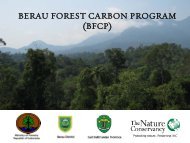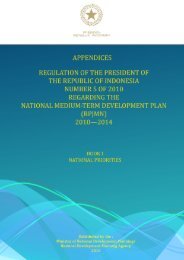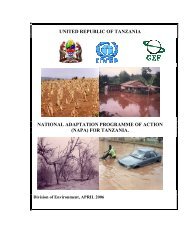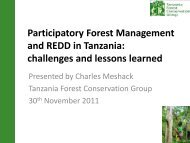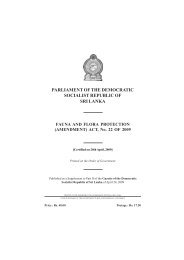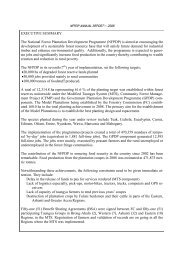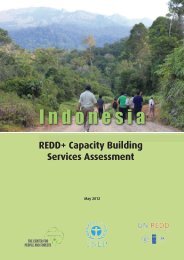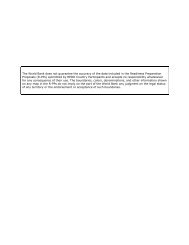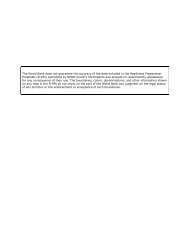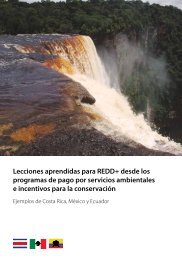PDF - The REDD Desk
PDF - The REDD Desk
PDF - The REDD Desk
Create successful ePaper yourself
Turn your PDF publications into a flip-book with our unique Google optimized e-Paper software.
Table 5: Recommendations for Ghana’s <strong>REDD</strong>+ Registry<br />
Aspect of the Registry<br />
Managing & Structuring a Registry<br />
Operating a Registry<br />
Linkages & Scales<br />
Financing a Registry<br />
Ghana Recommendation<br />
Management & Admin Body: Expand National <strong>REDD</strong>+ Secretariat to host <strong>REDD</strong>+<br />
registry, with oversight by National Climate Change Steering Committee<br />
Designate Forest & MRV Unit: Situate this unit at Forestry Commission (RMSC)<br />
with expert advisory board made up of FC, CERSGIS, and FORIG staff, and with<br />
NGO/civil society representation.<br />
System Operator: Conduct an assessment to determine whether local or<br />
international expertise is required, and if possible use Ghanaian expertise. 3 rd<br />
party operator is preferable to in-house operation from standpoint of efficiency,<br />
commitment to quality, and timeliness.<br />
Platforms & Technology: Choose Open Source software (option #2 described<br />
above) because it provides greater short and long-term affordability, security,<br />
flexibility. Ask UN-<strong>REDD</strong> / FCPF to support transfer and adaptation of opensource<br />
technology to partner countries (e.g. TerraCongo being adapted to<br />
Ghana context). This promotes intra-African learning and falls within mandate<br />
of <strong>REDD</strong>+ capacity building.<br />
Implementation: It is highly recommended that Ghana adopt a phased approach<br />
to implementation so that the goals and value of a registry are balanced by<br />
capacity, demand, piloting progress, and costs.<br />
Linkages: At least initially, adopt VCS/CCBA standards for <strong>REDD</strong>+ projects but<br />
quickly move to open up conversations with CDM DNA (EPA) and NAMA registry<br />
to make sure that CDM Forestry and Carbon Stock Enhancement accounting,<br />
NAMA accounting, and <strong>REDD</strong>+ project accounting are in alignment.<br />
Scale: Develop a national-level registry that covers all “<strong>REDD</strong>-able” areas of the<br />
country, but could incorporate data filters that enable managers/operators to<br />
assess project development and emissions reductions at various scales or<br />
geographies. It is conceivable that this registry could be paired to other national<br />
climate change registries, like a future NAMA registry, with the <strong>REDD</strong>+ registry as<br />
one type or sub-set of NAMAs. This registry could also incorporate CDM<br />
projects. For accounting purposes, emissions reductions from <strong>REDD</strong>+ should be<br />
compatible with other types of emissions reductions and should feed into the<br />
national emissions accounting process for the AFOLU sector.<br />
It is recommended that a national approach would be the best option for a<br />
country like Ghana, which is a Republic of relatively small area (as compared to<br />
countries like DRC, Ethiopia, etc) with emerging capacity and financial resources<br />
in terms of <strong>REDD</strong>+. What is interesting in this option is that while Ghana seeks to<br />
establish sub-national <strong>REDD</strong>+ reference levels, based on ecological gradients and<br />
deforestation driver variables, a national registry could function to help monitor<br />
activities and account for emissions reductions within the context of each subregion.<br />
Eventually, emissions reductions could be allocated to projects based on<br />
a “cookie-cutter” approach that was managed and monitored within the<br />
registry.<br />
Set-up the registry using financial support for the R-PP process and associated<br />
donor sources. Generate at least partial operational capital from registry fees,<br />
and then institute a percentage-based levy on emissions reductions transactions<br />
(market or fund based) to support the services that the registry provides and<br />
associated maintenance costs. In the long term, the registry should be selffinancing.<br />
16



